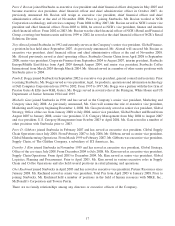Starbucks 2008 Annual Report Download - page 28
Download and view the complete annual report
Please find page 28 of the 2008 Starbucks annual report below. You can navigate through the pages in the report by either clicking on the pages listed below, or by using the keyword search tool below to find specific information within the annual report.Item 7. Management’s Discussion and Analysis of Financial Condition and Results of Operations
General
Starbucks Corporation’s fiscal year ends on the Sunday closest to September 30. Some fiscal years include
53 weeks. The fiscal years ended on September 28, 2008, September 30, 2007 and October 1, 2006 all included
52 weeks. All references to store counts, including data for new store openings, are reported net of related store
closures, unless otherwise noted.
Management Overview
Fiscal 2008 — The Year in Review
Throughout fiscal 2008, Starbucks continued to experience declining comparable store sales in its US stores,
primarily due to lower customer traffic. With the US segment representing 76% of consolidated revenues, the
impact of this decline on the Company’s financial results for fiscal 2008 was significant. For fiscal year 2008
comparable store sales declined 5% in the US, with a declining trend over the course of the year, ending with a
decline of 8% in the fourth quarter. The Company also experienced declining comparable sales in Canada and the
UK, its two largest Company-operated International markets, primarily due to lower traffic. The Company believes
that the weaker traffic has been caused by a number of ongoing factors in the global economies that have negatively
impacted consumers’ discretionary spending, as well as factors within the Company’s control with respect to the
pace of store openings in the US and store level execution. In the US, the economic factors included the higher cost
of such basic consumer staples as gas and food, rising levels of unemployment and personal debt, reduced access to
consumer credit, and lower home values as well as increased foreclosure activity in certain areas of the country
(California and Florida) where Starbucks has a high concentration of Company-operated stores. These develop-
ments combined with recent and ongoing unprecedented shocks to the global financial system and capital markets
have all contributed to sharp declines in consumer confidence in the US.
Starbucks business is highly sensitive to increases and decreases in customer traffic. Increased customer visits
create sales leverage, meaning that fixed expenses, such as occupancy costs, are spread across a greater revenue
base, thereby improving operating margins. But the reverse is also true — sales de-leveraging creates downward
pressure on margins. The softness in US revenues during fiscal 2008 impacted nearly all consolidated and US
segment operating expense line items when viewed as a percentage of sales.
Since January 2008, when Company founder Howard Schultz reassumed the role of president and chief executive
officer in addition to his role as chairman, Starbucks has taken steps to address the deterioration in the US retail
environment and address its global support structure. These included the development and implementation of
several important strategic initiatives as part of a transformation strategy designed to reinvigorate the Starbucks
Experience for the Company’s customers, increase customer traffic in its US stores, reduce infrastructure expenses,
and improve the Company’s results of operations. These significant actions have been designed to structure the
Company’s business for long-term profitable growth.
As a result of the continued weak economy and decreased customer traffic, as well as the costs associated with the
store closures and other actions in its transformation strategy, the Company’s fiscal 2008 results were negatively
impacted in the following ways:
• Consolidated operating income was $503.9 million in fiscal 2008, and operating margin for the year was
4.9% compared with 11.2% in the prior year. Approximately 260 basis points of the decrease in operating
margin was a result of restructuring charges, primarily related to the significant US store closures. Softness
in US revenues along with higher cost of sales including occupancy costs and store operating expenses were
also significant drivers in the margin decline.
• EPS for fiscal 2008 was $0.43, compared to EPS of $0.87 per share earned in the prior year. Restructuring
charges and costs associated with the execution of the transformation agenda impacted EPS by approx-
imately $0.28 per share in fiscal 2008.
22
























